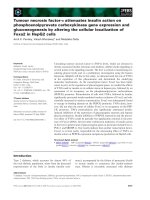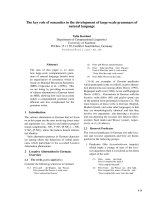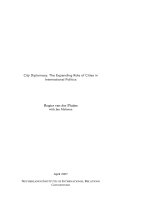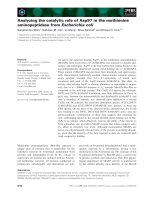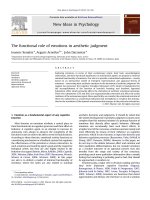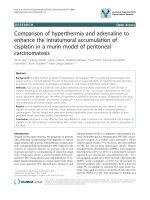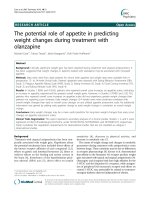Performance Measurement System and Lecturers’ Performance: Testing The Mediation Role of Competency In Malaysian Research Universities
Bạn đang xem bản rút gọn của tài liệu. Xem và tải ngay bản đầy đủ của tài liệu tại đây (473.45 KB, 17 trang )
Seediscussions,stats,andauthorprofilesforthispublicationat: />
PerformanceMeasurementSystemand
Lecturers'Performance:TestingTheMediation
RoleofCompetencyInMalaysia....
Article·January2015
CITATIONS
READS
4
218
4authors:
SharulEffendyJanudin
RuhanitaMaelah
UniversitiPendidikanSultanIdris(UPSI)
NationalUniversityofMalaysia
11PUBLICATIONS10CITATIONS
31PUBLICATIONS115CITATIONS
SEEPROFILE
SEEPROFILE
AmizawatiMohdAmir
NorLizaAbdullah
NationalUniversityofMalaysia
NationalUniversityofMalaysia
13PUBLICATIONS39CITATIONS
17PUBLICATIONS45CITATIONS
SEEPROFILE
SEEPROFILE
Someoftheauthorsofthispublicationarealsoworkingontheserelatedprojects:
Enterpriseriskmanagementandperformance:TheModeratingroleofHumancapitalViewproject
StrategicManagementAccountingViewproject
AllcontentfollowingthispagewasuploadedbySharulEffendyJanudinon07June2016.
Theuserhasrequestedenhancementofthedownloadedfile.
International Business Education Journal Vol. 8 No. 1 (2015) 105-120
Performance Measurement System and Lecturers’
Performance: Testing The Mediation Role of Competency
In Malaysian Research Universities
Sharul Effendy Janudina, Ruhanita Maelahb, Amizawati Mohd Amirb, Nor Liza Abdullahb
a
Universiti Pendidikan Sultan Idris, Malaysia,
b
Universiti Kebangsaan Malaysia, Malaysia
Abstract
Since performance of lecturers is the key contributor of academic excellence, universities need to empower their
human capital to be competitive and subsequently achieve world-class status. Unfortunately, efforts to conduct
research on measuring the performance of higher education institutions face a major setback compared to other
industries due to its complex nature and difficulty in measuring its outputs. Furthermore, a review of literature
indicates that research conducted in the education environment mainly focuses on organizational performance
rather than work performance. This study fills the gap by providing a research framework focusing on the
Theory of Work Performance. The interaction between performance measurement system and competency on
the work performance of lecturers at the individual level was investigated through the analysis of data gathered
from 368 academic staff from five Malaysian research universities. The findings indicate that 1) performance
measurement system (PMS) is positively associated with lecturers’ performance; 2) competency is positively
associated with lecturers’ performance; 3) competency partially mediates the relationship between performance
measurement system and lecturers’ performance.
Keyword:
Performance Measurement System, Competency, Institute of Higher Learning
INTRODUCTION
The transformation introduced by the universities in recent times had been due to
various factors such as the increasing number of students, budget constraints, globalization,
and the desire to introduce a more rational management style. As a result, the public sector
management style was introduced in the early 1980s and modifications in management
control systems were initiated. For example, special attention has been given to the provision
of financial budgets, management, models of workload allocation and performance
measurement quality. Even though research with respect to allocation of resources and the
accounting system at the university level is growing, a study of performance measurement
and management at department and staff level in university is still lacking (Bogt & Scapens,
2009).
External and internal pressures force the university to improve its governance system,
organizational structure and management style. Evidence can be seen through the adaptation
of management tools and practices by profit entities, especially performance measurement
system into the university’s management activities. For example, University of Siena, Italy
has been actively using dynamic performance measurement system when carrying out
teaching, research activities and management (Barnabè & Riccaboni, 2007). University
corporatization and transformation into an autonomous university forces the management to
find the best way to get financial resources. A new style of public management has been
adapted to the very essence of corporate management styles in university. The most
significant effect is the basis of defining the university management style, mission, shared
values and lecturer roles (Parker, 2011).
International Business Education Journal Vol. 8 No. 1 (2015) 105-120
In this paper, the present PMS of university was evaluated based on a comprehensive
PMS model. Prior research in the area of PMS has focused on its relationship with
organizational performance rather than work performance. In addition, there are limited
studies which examine the behavioural consequences and motivational mechanisms of
performance measurement system on individual work performance especially in the
education environment. Therefore, this framework will examine the relationship between
PMS and work performance at public research universities in Malaysia. This study also
investigates the influence of competency on work performance. Competency refers to
individuals feeling proud and happy with their achievement as the working environment
satisfies their expectations (Na, Amzat, & Abolhaija, 2011). Several studies found that
competency has influence on work performance of individuals, including in education
settings. The interest to study competency among academics is motivated by the operational
nature of university which is labour-intensive and the fact that budget spending of university
is dominated by academic development expenses (Toker, 2011). Competency is expected to
influence work and subsequently organization performance.
Effects of PMS in the organization have always been the focus of many researchers, but
studies on its effects at the individual level is still lacking despite the fact that measurement
of university excellence in teaching, research, publications and community service merely
depends on the individual academics. This study also fills the gap by focusing on work
performance of lecturers. The framework to analyze the interaction was established between
PMS and competency based on Theory of Work Performance which emphasizes on the
interaction between opportunity and willingness to achieve high work performance. This
paper will thus attempt to answer the following questions:
1. Does the performance measurement system influence the lecturers’ work
performance?
2. Does the competency influence the lecturers’ work performance?
3. Does the competency mediate the relationship between performance measurement
system and lecturers’ work performance?
LITERATURE REVIEW
Higher education in Malaysia
Malaysia has been successful in democratizing higher education and in producing
sufficient graduates to meet its manpower requirements over the last three decades. As an
example, the higher education capacity in Malaysia has grown from the formation of the
country’s first university, Universiti Malaya in 1961, to 20 public universities, 24 private
universities, 22 university colleges, four branches campuses of international universities, 21
polytechnics, 37 public community colleges and 390 private colleges as end of 2011
(Ministry of Higher Education Malaysia, 2012).
As a platform to move forward, The National Higher Education Action Plan 2007-2010
was formalized and it currently functions as a stepping stone towards promoting long-term
objectives of human capital development contained in the National Higher Education
Strategic Plan (Ministry of Higher Education Malaysia, 2007). The ultimate aim is to
empower the Malaysian higher education in order to meet the nation’s developmental needs
and to build its stature both at home and internationally. Seven strategic thrusts have been
outlined:
ISSN 1985 2126
106
International Business Education Journal Vol. 8 No. 1 (2015) 105-120
1.
2.
3.
4.
5.
6.
7.
Widening access and enhancing equity
Improving the quality of teaching and learning
Enhancing research and innovation
Strengthening Institution of higher education
Intensifying Internalization
Enculturation of lifelong learning
Reinforcing the Higher Education Ministry’s delivery system
Due to the globalization of higher education, universities around the world have
widened their influence in recent years through classifications such as world university
rankings, global university rankings using bibliometrics and global university rankings using
web metrics (Liu & Cheng, 2011). Each ranking system has specific dimensions to measure
university performance. For example, Times Higher Education System (THES) in 2014 used
five dimensions (Table 1) and the dimensions used by this ranking show that the performance
of lecturers contributes to merely 60 percent of the overall performance of the university.
Therefore, universities need to empower its human capital to be competitive and
subsequently achieve world-class status.
Table 1: THES 2014 Indicator
Dimensions
Teaching – the learning environment
Research – volume, income and reputation
Citation – research influence
Industry Income – innovation
International outlook – staff, students and research
Weighted (%)
30%
30%
30%
2.5%
7.5%
Source : Times Higher Education (2015)
The demand for higher education in Malaysia is expected to grow as population
increases in tandem with the government’s emphasis on human capital development. Ranking
classification among universities has significant influence towards the universities’
management process in Malaysia. The World Bank Report entitled Malaysian Economic
Monitor: Smart Cities 2011 highlighted the fact that Malaysia spends slightly more than most
countries on its tertiary educations. Unfortunately, leading Malaysian universities perform
relatively poorly in global rankings. As an immediate action, further measures to improve
university performance should be adopted (The World Bank, 2011).
The Ministry of Education Malaysia has carried out various efforts to improve the
status of Malaysian higher education institutions as a centre of excellence in education
internationally. For example, public universities are categorized into either research, focused
or comprehensive universities. In another development, the government grants autonomy
status to public universities which meet the requirements. Financial allocation to these
universities is given based on the performance of the institutions and the code of governance
and governance index have been developed to enhance accountability. Autonomy is also
expected to expedite the transformation process of the universities. Accelerated Programme
for Excellence (APEX) was introduced in 2008 with the underlying purpose to increase
innovation, performance and encourage excellence among public universities. In February
2015, the Malaysian Education Blueprint 2015 – 2025 (Higher Education) with 10 thrusts
was launched. It is expected to be a robust action plan to make Malaysia a global player and
leading education hub at the international level (Ministry of Education Malaysia, 2015). As
an agent of economic environment change, universities have to be proactive in planning and
controlling their activities as they have to responsible and accountable to the stakeholders.
ISSN 1985 2126
107
International Business Education Journal Vol. 8 No. 1 (2015) 105-120
Performance measurement system is workable as a means to implement strategy, align
behaviours and support decision making (Franco-Santos et al., 2007).
Performance measurement system (PMS)
PMS is a mechanism used by the management to supervise and control the direction of
the organization. It plays an important role in developing corporate strategy and performance
evaluation for the organization to be more competitive in the global economy (Ukko,
Tenhunen, & Rantanen, 2007). It identifies individual effectiveness at all hierarchical levels
within an organization (Ubeda & Santos, 2007). Performance measurement also prepares
useful information in the decision-making process (Ukko et al., 2007) and assists managers in
planning and controlling (Chenhall & Langfield-Smith, 2007) in order to achieve good
results.
A comprehensive PMS relates to its multiple measurements, focus on strategic
planning, integrative and incentive (Buhovac & Groff, 2012). Hall (2011) defines
comprehensive PMS as the ability of the system to supply enhanced performance information
which links performance and individual role by providing a broad set of measures related to
the importance of the organization, the integration of measures with strategy and valued
organizational outcomes, and the integration of measures across functional boundaries and
the value chain. Multidimensionality refers to a combination of financial and non-financial
measures, objectives and performance measures. Generally, comprehensive performance
measurement system refers to the use of various performance measures which combine
financial and non-financial measures, emphasize the role of information in the organization
and connect all the activities carried out within the organization. All measurements having
relationships with each other will interact and integrate to form a consensus. As a result,
performance measurement systems used by an organization enables information-sharing
among employees.
The consequences of performance measurement system can be divided into three
categories: people’s behaviour, organizational capabilities, and performance consequences
(Franco-Santosa, Lucianetti, & Bournea, 2012). A few examples of positive effects on
behaviour are managerial learning and decision-making (Grafton, Lillis, & Widener, 2010),
role clarity (Hall, 2008) while positive consequences on organizational capabilities are the
quality of being innovative (Henri, 2006), strategic alignment (R. Chenhall, 2005) and
management practices (Ukko et al., 2007). Empirical research clearly promotes the
significant relationship between performance measurement system and performances at the
organizational level and individual level. Furthermore, research on performance measurement
system at service organization especially in universities is scarce due to the difficulty in
measuring output and processes (Zangoueinezhad & Moshabaki, 2011). Most of the research
conducted focus on university aggregate performance by using contingency theory (Chung,
Harrison, & Robert C, 2009), institutional theory (Bogt & Scapens, 2009).
Competency
Competency in employment affects work productivity as well as the survival of an
organization. Competencies can be divided into two types: specific and general. Specific
competency refers to the cognitive requirements needed by employees to enable them to
work. Examples are the skills possessed by a carpenter to design furniture which is required
by the customer. However, technological change and transition requirements of the labour
market has made competency vulnerable to depreciation (Allen, Ramaekers, & Velden,
2005). General competency refers to the knowledge, skills, codes of conduct, and personal
ISSN 1985 2126
108
International Business Education Journal Vol. 8 No. 1 (2015) 105-120
characteristics possessed by every member in organization. Examples of general competency
are discipline, integrity, transparency, self-leadership qualities, team collaboration, initiative,
creativity and analytical skills.
Competency is also defined as the ability and talent which translates the ability,
behaviour and manifestation of intention owned by individuals (Boyatzis, 2008). Talent is
measured through values, vision and personal philosophy; knowledge, competency, career
development, interests and style. According to Boyatzis (2008b), there are three clusters of
competencies: expertise and experience, knowledge and cognitive efficiency. This
competency would not be static because it can be developed in the performance measurement
system. According to Slocum, Jackson and Hellriegel (2008), competency is a combination
of knowledge, skills, behaviour and attitude which contributes to the efficiency of the
individual. For example, a manager should possess six core competencies: communication,
planning and administration, teamwork, strategic action, cultural diversity and selfmanagement. According to existing literature, competency theory can be divided into three
perspectives: competencies at the individual level, organizational competencies and
competency as a tool of communication between the education field and the labour market
(Garavan & McGuire, 2001; Kalargyrou and Woods, 2001). In the higher education sector,
lecturers should have high competency in teaching (Ullah, Khan, Murtaza, & Din, 2011),
research (Clarke, Flanagan, & O’Neill, 2012), supervision (Paglis, Green, & Bauer, 2006)
and publication (Mayrath, 2008).
Lecturers’ work performance
Performance measurement process of an organization is an important and challenging
task for the management due to the difficulty in determining the appropriate constructs during
the process. The task becomes more significant when it involves many employees in large
organizations particularly if the process of reviewing will be carried out at individual level.
Murphy (2008) stated that academic debates about the relationship between performance
measurement and performance are interesting and useful, but they might not be helpful to the
practitioners in improving performance measurement. Hence, the basic question to be
answered is whether the constructs could be related to job performance.
The main objective of university is to develop knowledge through teaching, research
and social service. The university requires lecturers with high competencies to ensure
teaching and learning activities work effectively. At the individual level, lecturers were
affected by participation in decision-making process (Sukirno & Siengthai, 2011), emotional
intelligent (Mustafa & Amjad, 2011), teaching and research efficiency (Sellers-Rubio, MasRuiz, & Casado-Díaz, 2010), goal orientation (Jackson, Hobman, Jimmieson, & Martin,
2009), goal orientation (Jackson et al., 2009), job stress (Kalyani R., Panchanatham N., &
Parimala R., 2009), organizational commitment (Smeenk, Teelken, Eisinga, & Doorewaard,
2009) and psychological ownership (Samsinar Md-Sidin, Sambasivan, & Muniandy, 2009).
In measuring lecturers’ work performance, researchers used particular dimensions.
For example, Abdulsalam and Mawoli (2012) identified positive and moderate relationship
between motivation and teaching performance while the relationship between motivation and
research was negative. In Indonesia, Sukirno and Siengthai (2011) found lecturers’
participation in decision making process has significant effect towards lectures’ work
performance in teaching, research activities, publication, social works and consultation.
Universities in South Africa, United States of America, United Kingdom, Australia and
Nigeria pay more attention on teaching and research performance among their lecturers
(Molefe, 2010).
ISSN 1985 2126
109
International Business Education Journal Vol. 8 No. 1 (2015) 105-120
HYPOTHESIS DEVELOPMENT
Theory of work performance
The Theory of Work Performance by Blumberg and Pringle (1982) was used in the
development of the structural relationship among the variables of the study. The following
sections briefly explain the theory to provide a deeper understanding on how it might explain
the hypothesized relationship.
Organizational excellence depends on its ability to optimize resources such as financial,
equipment and manpower. However, existing theories have failed to provide the basis to
forecast individual employee excellence (Blumberg & Pringle, 1982). Therefore, the
interaction between the ability to perform tasks, willingness to perform tasks and opportunity
has been recommended by Blumberg and Pringle (1982) as a theory which can be used to
predict individual work performance. In their working paper on the proposed exploration of
the three-dimensional aspects, Blumberg and Pringle have called it as the theory of work
performance.
The ability to perform refers to the physiological and cognitive capacity allowing
individuals perform effectively. Examples are individual knowledge, skills, intelligence,
health and stamina. While the psychological characteristics and emotions which influence the
degree of an individual's ability to perform each task refers to the willingness to carry out
tasks. Willingness can be associated with the effects of job satisfaction, personality, job
involvement, attitude and expectations for the role of perception.
Even if an individual has the ability to perform the work and willingness to do their
work, there are also situations in which the individual fails to achieve excellence
performance. This is because there are environmental factors which contribute towards the
excellence of the work done. Examples of environmental factors which affect an individual’s
work are colleagues, supervision, policies and rules of the organization. Blumberg and
Pringle (1982) suggest three interactional factors as a function of individual work
performance and forecasting can be noted in the form p = f (capacity x willingness x
opportunities). This interaction is shown in Figure 1.
Capacity
Performance
Willingness
Opportunity
Figure 1: Dimensions of Work Performance
Pringle and Blumberg (1986) suggest several aspects of the opportunity to increase
performance and need to be given attention by the manager. They point out the managers are
responsible for providing a good working environment. Among the measures proposed are to
analyze the level of technology used in an organization, upgrade production system uses,
ISSN 1985 2126
110
International Business Education Journal Vol. 8 No. 1 (2015) 105-120
selecting employees which could affect colleagues, mentoring system and widen the
employee empowerment by giving more responsibilities to employees.
Research framework in a university setting
The variables used in this study are PMS, and competency which represent the two
dimensions of Theory of Work Performance (opportunity and capacity). PMS refers to the
process performed by managers in planning, controlling and measuring expected
performance. The management of an organization needs to ensure staff have high
competency to perform effectively. In order to excel at work, individuals need to have the
capacity to perform. Competency refers to a combination of knowledge, skills and abilities of
individual employees and it relates directly to the work of the individual. The independent
variable in this study is work performance. Work performance is used to measure the
contribution of academics through in-role performance. The research framework of this study
is shown in Figure 2 below:
Competency
Performance
Measurement
System
Work
Performance
Figure 2: Research framework
Performance measurement system and work performance
PMS is an important and effective mechanism to control and ensure that managers’
performance is in line with the objectives of organization. According to Hoque (2004), the
adaptation of multiple performance measurement is able to provide signal and motivation.
Hall (2008) shows that comprehensive PMS prepares operational and strategic information
for managers to better understand their role and responsibilities to achieve better
performance. Similarly, comprehensive PMS has an impact on the performance improvement
of individuals (Webb, 2004; Hall 2008). In addition, PMS is argued to be strategic (Burney
and Widener, 2007) and dynamic (Gimbert, Bisbe, & Mendoza, 2010) in order to be
effective. Rahman and Shah (2012) found a positive relationship between PMS and
performance of academics from 16 public universities in Khyber Pakhtunkhwa, Pakistan. In
Australia, non-financial items in performance measurement system influence managers’
performance rather than financial items (Hall, 2011). Therefore, the following effect is
hypothesized:
H1: PMS is positively associated with lecturers’ work performance
Competencies and work performance
Individuals with high competency are expected to achieve high work performance
because competency is a trait found in one individual which allows them to carry out a task
given effectively (Dubois, Rothwell, Stern, & Kemp, 2004). Chreptaviciene and Starkute
(2012) acknowledge that work performance increases when individuals believe they have the
power to decide on how the work should be performed. Competency in carrying out
ISSN 1985 2126
111
International Business Education Journal Vol. 8 No. 1 (2015) 105-120
responsibilities is stated as defined in the specification of work (Boyatzis, 2008). Analysis
made on 53,660 assessments by the manager, head of private companies and cooperatives in
Italy found that emotional competence, social competence and cognitive competence
influence management and leadership (Boyatzis and Ratti, 2009). In addition, a study
conducted among executives in Spain shows emotional competence and personality are
important predictors of work performance (Ramo, Saris, & Boyatzis, 2009). Furthermore
emotional and social intelligence competencies are found to be practical, have a level of trust
and high validity for assessing and developing individual workers in different cultures
(Emmerling & Boyatzis, 2012). In general, positive relationship exists between competency
and work performance. Therefore, the following effects are hypothesized:
H2: Competency is positively associated with lecturers’ work performance
PMS, competency and work performance
The nature of working as a lecturer requires teaching competency, competency inquiry,
social competency and personal competency (Shavaran, Rajaeepour, Kazemi, & Zamani,
2012). The issue of imbalance competency is expected to be reduced through comprehensive
PMS. Marin (2012) identified performance measurement system as having positive influence
towards work performance and competency of middle managers in Canada. Changes in
performance measurement system will encourage employees to react to the level of
competency needed in performing their job (Medlin & Jr, 2009). Furthermore, feedback in
management accounting needs to be analysed critically to avoid misunderstanding among
employees (Pitkanen & Lukka, 2011). Basically, high competency would result in
continuously increased effort which would eventually improve the performance. Therefore,
the following effects are hypothesized:
H3: Competency mediates the relationship between PMS and lecturers’ work
performance
RESEARCH METHOD
Data collection
The study was conducted using a survey method. The sample consisted of 1500
lecturers from Malaysian Public Research universities who were selected based on stratified
random sampling method. Three levels of strata applied were faculties, departments and job
ranks. The questionnaire was divided into four parts: Part A (items) to obtain background
information on the respondents, Section B (five items) aims at measuring the performance
measurement system. The questionnaire on performance measurement system was adapted
from Hall (2008) and Chenhall (2005). An example of items on performance measurement
system are “The performance measurement system (PMSs) provides a broad range of
performance information about different areas of the university” and “(PMSs) provides a
diverse set of measures related to the key performance areas of the university”. An instrument
developed by Jeya and Mohamad Sahari (2011) was used in part C to measure teaching
competency level among lecturers. An example of items on teaching competency includes
preparing materials for teaching and facilitating student discussion in class. Lecturers’ work
performance was measured based on an instrument developed by Smeenk et al. (2009). Seven
items on measuring lecturers’ performance included teaching, supervision, research,
consultation, publication, paper presentation and overall performance. Respondents were
required to give response on a statement based on scale 1 – 7.
ISSN 1985 2126
112
International Business Education Journal Vol. 8 No. 1 (2015) 105-120
Profile of respondents
A total of 1500 questionnaires were distributed and 384 questionnaires were returned.
After deleting 16 questionnaires due to incomplete responses, only 368 were included in the
final analysis. Even though the response rate was only 26%, this fulfilled the requirement of
structural equation modelling with more than 300 (Tabachnick & Fidell, 2013). The test on
common method bias by Harman single factor test showed no single factor existing as the
dominant factor (Podsakoff & Organ, 1986). Table 2 shows the demographic profile of the
respondents.
Table 2 : Demographics of respondent
Gender
Male
Female
Age (years)
25 – 30
31 – 35
36 - 40
41 – 45
46 - 50
Above 50
Academic Qualification
Bachelors
Masters
Doctor of Philosophy
Profesional / Specialize
JJob Position
Lecturer
Senior Lecturer
Associate Professor
Professor
Working Experience in current university (years)
1–5
6 – 10
11 – 15
16 – 20
Above 20
Frequency
Percentage (%)
183
185
49.7
50.3
6
29
60
103
62
108
1.6
7.9
16.3
28
16.8
29.3
1
33
305
29
0.3
9.0
82.9
7.9
33
141
118
76
9.0
38.3
32.1
20.7
46
69
83
68
102
12.5
18.8
22.6
18.5
27.7
ANALYSIS AND RESULTS
The research framework in which the relationship between CPMS and work
performance is mediated by competency is presented in Figure 2. A structural equation model
(SEM) was used to test for the mediation in H3 in one stage, rather than using the two-stage
approach of Baron and Kenny (1986). The SEM was estimated using a full information
maximum likelihood procedure. A bootstrapping method was used to construct a sampling
distribution in order to develop test statistics and assess the uncertainty. This method makes
fewer assumptions and has more power (while maintaining reasonable type-1 error), and is
therefore the currently recommended analysis approach (MacKinnon, Fairchild, & Fritz,
2007). One thousand resample (with replacement) were drawn from the original sample and
bias corrected bootstrap confidence intervals were computed for the indirect effects.
Descriptive statistic and inferential statistics were used to analyse the data. The confidence
interval level for statistical significance was set at a value of 95% (p ≤ 0.05) for confirmatory
factor analysis and a value of 99% (p ≤ 0.01) for correlations.
ISSN 1985 2126
113
International Business Education Journal Vol. 8 No. 1 (2015) 105-120
Table 3 shows the result of data reliability (Cronbach’s α), factor items and mean,
factor loading (β), critical ratio (CR), standard errors (SE) and significance level (P). The
reliability results show that each factor has Cronbach’s alpha more than 0.70 which indicates
that each factor has high reliability (Hair, Black, & Anderson, 2010). Factor loadings for each
item were also above 0.50. Hair et al. (2010) recommend the minimum factor loading of 0.30
for a sample of more than 350 respondents.
Table 3 : Results of Confirmatory Factor Analysis (CFA)
Factors
Cronbach’s
α
Compreh
Performance
Measurement
System
(CPMS)
Teaching
Competency
(TEA)
Work
Performance
(WORKPERF)
0.937
0.930
0.892
Items
Mean
β
cp1
cp2
cp3
cp4
cp5
t1
t2
t4
t5
t6
t7
t8
t9
t11
t12
wi1
wi2
wi3
wi4
wi5
wi6
wi7
5.2310
5.2554
5.0408
5.0815
5.0082
5.8207
5.7799
5.6875
5.8234
5.4647
5.9592
5.6495
5.6875
5.7799
5.7120
4.0897
3.8777
3.6060
3.4538
3.1495
3.5027
3.7418
0.832
0.870
0.882
0.885
0.859
0.742
0.770
0.728
0.785
0.709
0.815
0.827
0.746
0.730
0.727
0.584
0.698
0.863
0.882
0.517
0.736
0.894
CR
SE
P
20.919
21.382
21.496
20.461
.051
.056
.055
.057
***
***
***
***
15.001
14.095
15.306
13.703
15.972
16.225
14.477
14.140
14.078
.075
.077
.072
.082
.072
.074
.073
.079
.077
***
***
***
***
***
***
***
***
***
14.717
12.155
12.297
8.511
11.023
12.386
.093
.167
.180
.160
.145
.139
***
***
***
***
***
***
Note: *** indicates the level of significance at 0.01
As can be seen from Figure 3, the ratio of chi-square to the degree of freedom (2/df) is
2.603. This value is acceptable and below the threshold value (≤ 3) and thus indicate a good
fit (Kline, 2011). Furthermore, additional goodness-of-fit parameters of CFI (comparative fit
index) and TLI (Tucker-Lewis index) are over the minimum threshold of 0.9 (Hair et al.,
2010). These findings are also supported by RMSEA (root mean square of approximation)
and SRMR (standardized root mean square residual) value less than the recommended value
of 0.08 (Hu and Bentler, 1999; Bentler, 1990). All this data indicate that the proposed model
does fit the research data.
ISSN 1985 2126
114
International Business Education Journal Vol. 8 No. 1 (2015) 105-120
Figure 3 : Structural model of relationship between performance measurement system,
competency and work performance
Three hypotheses had been developed and tested for this research. Table 4 shows the
result of direct relationship between performance measurement system, competency and
work performance. Both hypotheses were supported and significant at p ≤ 0.01.
Bootstrapping was used to test the mediation effect and the result showed that competency
partially mediated the relationship between performance measurement system and work
performance (Table 5). According to Zainudin (2014), if the result of indirect and direct
relationship is significant, the nature of mediation is partial mediation.
Table 4 : Result of direct relationship
Hypotheses
H1
H2
Note:
WORKPERF
WORKPERF
Path
<--<---
PMS
TEA
Estimate
0.099
0.147
S.E.
0.027
0.035
C.R.
3.682
4.149
P
***
***
Result
Significant
Significant
*** indicates the level of significance at 0.01
PMS = Performance Measurement System
TEA = Teaching Competency
Table 5 : Result of mediation testing (PMS TEA WORKPERF)
Bootstrapping P-Value
Result
Type of mediation
Indirect effect
Direct effect
0.007
0.025
Significant
Significant
Partial mediation since both direct and indirect effects are significant
Note: *** indicates the level of significance at 0.05
DISCUSSION AND RECOMMENDATION FOR FUTURE RESEARCH
This study utilized SEM to explore the positive effect of performance measurement
system on work performance via competency as the mediator. Although many previous
studies explored the issue of performance measurement system and performance, there is
little research that has actually explored the relationship of performance measurement system
and work performance at the individual level. Interestingly, the research model developed in
this study is based on theory of work performance (Blumberg & Pringle, 1982) which
ISSN 1985 2126
115
International Business Education Journal Vol. 8 No. 1 (2015) 105-120
highlights the interaction of opportunity and capacity to increase the level of work
performance.
The study results showed that the relationship between performance measurement
system applied by the university management and the lecturers’ work performance is
significant. In Malaysia, the internalization and autonomy received by the university becomes
a push factor in achieving world-class university status. Any action and goals taken by the
management must take into consideration the stakeholder needs. Since a lecturer contributes
significantly in fulfilling the key performance indicator of the university, this study showed
that university performance measurement system had a significant effect on lecturers’ work
performance. The test on the relationship between competency and work performance also
showed that it is also significant. The mediation test indicated that competency partially
mediated the relationship between performance measurement system and lecturers’ work
performance. This is an evidence for any organization while doing the strategic planning
process to consider the capacity of their employee. The effect of performance measurement
system can be more effective if the goal of the organization is designed based on human
capacity in the organization.
This study contributes to the theory and practice by providing Malaysian evidence on
PMS design for the education sector. The study also provides empirical evidence of the
interaction between the two dimensions (opportunity and capacity) in the theory of work
performance which leads to high performance. For regulators and administrators, the results
can be meaningfully used as a guide to design and implement effective PMS, training, and
work setting for the academics. PMS should be a comprehensive tool in planning and
monitoring university performance as it provides a broad range of performance information.
PMS also covers a critical area of key performance measures and functions as a formal
document for sharing the strategic mission of the university.
References
Abdulsalam, D., & Mawoli, M. A. (2012). Motivation and job performance of academic staff of state
universities in Nigeria: The case of Ibrahim Badamasi Babangida University, Lapai, Niger
State. International Journal of Business and Management, 7(14), 142–148.
Allen, J., Ramaekers, G., & Velden, R. van der. (2005). Measuring competencies of higher education
graduates. In D. J. Weerts & J. Vidal (Eds.), Enhancing alumni reserach: European and
American perspectives, New Directions for institutional reserach (Vol. 126, pp. 49–59). San
Fancisco: Wiley Periodical.
Barnabè, F., & Riccaboni, A. (2007). Which Role for Performance Measurement Systems in Higher
Education? Focus on Quality Assurance in Italy. Studies in Educational Evaluation, 33(3-4),
302–319. doi:10.1016/j.stueduc.2007.07.006
Baron, R. M., & Kenny, D. A. (1986). The moderator-mediator variable distinction in social
psychological research: Conceptual, strategic and statistical consideration. Journal of
Personality and Social Psychology, 51(6), 1173 – 1182.
Blumberg, M., & Pringle, C. D. (1982). The missing opportunity in organizational research- some
implications for a theory of work performance. Academy of Management Review, 7(4), 560 –
569.
Bogt, H. J. ter, & Scapens, R. W. (2009). Performance Measurement in Universities : A comparative
study of two A & F groups in the Netherlands and the UK (Vol. 1).
Boyatzis, R. E. (2008). Competencies in the 21st century. Journal of Management Development,
27(1), 5–12.
ISSN 1985 2126
116
International Business Education Journal Vol. 8 No. 1 (2015) 105-120
Boyatzis, R. E., & Ratti, F. (2009). Emotional, social and cognitive intelligence competencies
distinguishing effective Italian managers and leaders in a private company and cooperatives.
Journal of Management Development, 28(9), 821–838.
Buhovac, A. R., & Groff, M. Z. (2012). Contemporary performance measurement systems in Central
and Eastern Europe: a synthesis of the empirical literature. Journal for East European
Management Studies, 1, 68 – 103.
Burney, L., & Widener, S. K. (2007). Strategic performance measurement system, job-relevant
information, and managerial behavioral responses - role stress and performance. Behavioral
Research in Accounting, 19, 43 –69.
Chenhall, R. (2005). Integrative strategic performance measurement systems, strategic allignment of
manufacturing, learning and outcomes: an exploratory study. Accounting, Organizations and
Society, 30, 395 – 422.
Chenhall, R. H., & Langfield-Smith, K. (2007). Multiple Perspectives of Performance Measures.
European Management Journal, 25(4), 266–282. doi:10.1016/j.emj.2007.06.001
Chreptaviciene, V., & Starkute, J. (2012). Relationship between Career and Competency :
Verification of Theoretical Model Validity. Engineering Economics, 23(2), 163–173.
Chung, T. K. J., Harrison, G. L., & Robert C, R. (2009). Interdependencies in organization design: A
test in universities. Journal of Management Accounting Research, 21, 55–73.
Clarke, K., Flanagan, J., & O’Neill, S. (2012). Success in winning Australian Research Council grants
as a measure of comparative professionalised disciplinary research activity. Pacific Accounting
Review, 24(1), 51–79.
Dubois, D. D., Rothwell, W. J., Stern, D. J. K., & Kemp, L. K. (2004). Competency-Based Human
Resource Management. M. Mountain View, California: Davies-Black Publishing.
Emmerling, R. J., & Boyatzis, R. E. (2012). Emotional and social intelligence competencies: cross
cultural implications. Cross Cultural Management: An International Journal, 19(1), 4–18.
Franco-Santos, M., Kennerley, M., Micheli, P., Martinez, V., Mason, S., Marr, B., … Neely, A.
(2007). Towards a definition of a business performance measurement system. International
Journal of Operations & Production Management, 27(8), 784–801.
Franco-Santosa, M., Lucianetti, L., & Bournea, M. (2012). Contemporary performance measurement
systems: A review of their consequences and a framework for research. Management
Accounting Research, 23, 79–119.
Garavan, T. N., & McGuire, D. (2001). Competencies & workplace learning: Some reflections on the
rhetoric & the reality. Journal of Workplace Learning, 13(4), 144–164.
Gimbert, X., Bisbe, J., & Mendoza, X. (2010). The role of performance measurement systems in
strategy formulation processes. Long Range Planning, 43, 477 – 497.
Grafton, J., Lillis, A. M., & Widener, S. K. (2010). The role of performance measurement and
evaluation in building organizational capabilities and performance. Accounting, Organizations
and Society, 35(7), 689–706. doi:10.1016/j.aos.2010.07.004
Hair, J. F., Black, W. C., & Anderson, R. E. (2010). Multivariate Data Analysis: A Global
Perspective (7th ed.). New Jersey, USA: Pearson Education.
Hall, M. (2008). The effect of comprehensive performance measurement systems on role clarity,
psychological empowerment and managerial performance. Accounting, Organizations and
Society, 33, 141 – 163.
Hall, M. (2011). Do comprehensive performance measurement systems help or hinder managers ’
mental model development ? Management Accounting Research, 22(2), 68–83.
doi:10.1016/j.mar.2010.10.002
ISSN 1985 2126
117
International Business Education Journal Vol. 8 No. 1 (2015) 105-120
Henri, J.-F. (2006). Organizational culture and performance measurement systems. Accounting,
Organizations and Society, 31, 77–103.
Hoque, Z. (2004). A contingency model of the association between strategy, environmental
uncertainty and performance measurement: impact on organizational performance.
International Business Review, 13, 485–502.
Hu, L., & Bentler, P. M. (1999). Cutoff criteria for fit indexes in covariance structure analysis:
Conventional criteria versus new alternatives. Structural Equation Modeling, 6, 1 – 55.
Jackson, C. J., Hobman, E. V, Jimmieson, N. L., & Martin, R. (2009). Comparing different approach
and avoidance models of learning and personality in the prediction of work, university, and
leadership outcomes. British Journal of Psychology, 100, 283–312.
Kalyani R., Panchanatham N., & Parimala R. (2009). Stress and strain: Faculty Performance. SCMS
Journal of Indian Management, April - Ju, 37–45.
Liu, N. C., & Cheng, Y. (2011). Global university rankings and their impact. In Philip G. Altbach
(Ed.), Leadership for world class universities. New York: Routledge.
MacKinnon, D. P., Fairchild, A. J., & Fritz, M. S. (2007). Mediation analysis. Annual Review of
Psychology, 58, 593 – 614.
Marin, J.-C. (2012). The impact of strategic planning and the balanced scorcard methodologgy on
middle managers’ performance in the public sector. International Journal of Business and
Social Science, 3(1), 114–127.
Mayrath, M. C. (2008). Attributions of productive authors in educational psychology journals.
Education Psychology Review, 20, 41–56.
Medlin, B., & Jr, K. W. G. (2009). Enhancing performance through goal setting, engagement, and
optimism. Industrial Management & Data Systems, 109(7), 943–956.
Ministry of Education Malaysia. (2015). Malaysia Education Blueprint 2015 - 2015 (Higher
Education). Putrajaya.
Ministry of Higher Education Malaysia. (2012). Malaysia Higher Education Statistic 2011. Putrajaya.
Ministry of Higher Education Malaysia (2007). National Higher Education Action Plan 2007-2010.
Putrajaya.
Molefe, G. N. (2010). Performance measurement dimensions for lecturers at selected universities: An
international perspective. SA Journal of Human Resource Management, 8(1), 1–13.
Murphy, K. R. (2008). Explaining the Weak Relationship Between Job Performance and Ratings of
Job Performance. Industrial and Organizational Psychology, 1, 148–160.
Mustafa, L., & Amjad, S. (2011). Emotional intelligence determining work attitudes and outcomes of
university teachers: Evidence from Pakistan. Interdisciplinary Journal of Contemporary
Research in Business, 2(10), 240–259.
Na, J., Amzat, I. H., & Abolhaija, J. H. (2011). A study of lecturers’ job satisfaction in selected
Harbin City universities, China. Interdisciplinary Journal of Contemporary Research in
Business, 3(1), 17–39.
P. M. Bentler. (1990). Comparative fit indices in structural models. Psychological Bulletin, 107, 238 –
246.
Paglis, L. L., Green, S. G., & Bauer, T. N. (2006). Does adviser mentoring add value? A longitudinal
study of mentoring and doctoral student outcomes. Research in Higher Education, 47(4), 451–
476.
Parker, L. (2011). University corporatisation : Driving redefinition. Critical Perspectives on
Accounting, 22(4), 434–450. doi:10.1016/j.cpa.2010.11.002
ISSN 1985 2126
118
International Business Education Journal Vol. 8 No. 1 (2015) 105-120
Pitkanen, H., & Lukka, K. (2011). Three dimensions of formal and informal feedbacks in
management accounting. Management Accounting Research, 22, 125–137.
Podsakoff, P. M., & Organ, D. W. (1986). Self-reports in organizational research: Problems and
prospects. Journal of Management, 12 (4), 531–544.
Pringle, C. D., & Blumberg, M. (1986). What really determines job performance? SAM Advanced
Management Journal, Autumn 198, 9 – 13.
Rahman, W., & Shah, B. (2012). The mediating effects of perceived employee development on the
relationships between performance appraisal and job performance in public universities of
Khyber Pakhtunkhwa, Pakistan. Business and Management Review, 2(1), 11–26.
Ramo, L. G., Saris, W. E., & Boyatzis, R. E. (2009). The impact of social and emotional
competencies on effectiveness of Spanish executives. Journal of Management Development,
28(9), 771 – 793.
Rex B Kline. (2011). Principles and practice of structural equation modeling (3rd ed.). New York:
The Guilford Press.
Samsinar Md-Sidin, Sambasivan, M., & Muniandy, N. (2009). Impact of Psychological Ownership on
the Performance of Business School Lecturers. Journal of Education for Business, 85, 50–56.
Sellers-Rubio, R., Mas-Ruiz, F. J., & Casado-Díaz, A. B. (2010). University efficiency:
Complementariness versus trade-off between teaching, research and administrative activities.
Higher Education Quartely, 64(4), 373–391.
Shavaran, S. H. R., Rajaeepour, S., Kazemi, I., & Zamani, B. E. (2012). Development and validation
of faculty members ’ efficacy inventory in higher education. International Education Studies,
5(2), 175–185. doi:10.5539/ies.v5n2pl75
Slocum, J. W., Jackson, S. E., & Hellriegel, D. (2008). Competency-based management. Mason,
USA: Thomson South Western.
Smeenk, S., Teelken, C., Eisinga, R., & Doorewaard, H. (2009). Managerialism, organizational
commitment, and quality of job performances among European university employees. Research
in Higher Education, 50, 589–607.
Sukirno, D. S., & Siengthai, S. (2011). Does participative decision making affect lecturer performance
in higher education? International Journal of Educational Management, 25(5), 494–508.
Tabachnick, B. G., & Fidell, L. S. (2013). Using multivariate statistics (6th ed.). New Jersey: Pearson.
The World Bank. (2011). Malaysian Economic Monitor : Smart Cities.
Times Higher Education. (2015). World University Rankings 2014-2015 methodology. Retrieved
April 22, 2015, from />Toker, B. (2011). Job satisfaction of academic staff: an empirical study on Turkey. Quality Assurance
in Education, 19(2), 156–169.
Ubeda, C. L., & Santos, F. C. A. (2007). Staff development and performance appraisal in a Brazilian
research centre. European Journal of Innovation Management, 10(1), 109–125.
doi:10.1108/14601060710720573
Ukko, J., Tenhunen, J., & Rantanen, H. (2007). Performance measurement impacts on management
and leadership: Perspectives of management and employees. International Journal of
Production Economics, 110(1-2), 39–51. doi:10.1016/j.ijpe.2007.02.008
Ullah, M. H., Khan, M. N. U., Murtaza, A., & Din, M. N. U. (2011). Staff development needs in
Pakistan higher education. Journal of College Teaching & Learning, 8(1), 19–24.
ISSN 1985 2126
119
International Business Education Journal Vol. 8 No. 1 (2015) 105-120
Velu, J., & Mohamad Sahari, N. (2011). Psychometric analysis of lecturers self efficacy instrument.
In B. K. Krause, M. C. Grimmer, & S. Purbrick-Illek (Eds.), Research and Development in
Higher Education: Reshaping Higher Education (pp. 372 – 382). Gold Coast.
Webb, R. A. (2004). Managers’ commitment to the goals contained in a strategic performance
measurement system. Contemporary Accounting Research, 21(4), 925–958.
Zainudin, A. (2014). A handbook on SEM for academicians and practitioners : Practical guide for the
beginners. Kuala Terengganu: Universiti Sultan Zainal Abidin.
Zangoueinezhad, A., & Moshabaki, A. (2011). Measuring university performance using a knowledgebased balanced scorecard. International Journal of Productivity and Performance
Management, 60(8), 824–843. doi:10.1108/17410401111182215
ISSN 1985 2126
View publication stats
120

